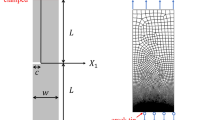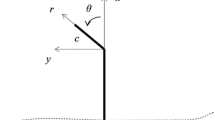Abstract
Tensile softening essential to the well-known fictitious crack model should be independent of specimen size and test methods. Commonly observed size effect (SE) on tensile softening relations measured from direct tensile specimens with smooth surface needs to be explained in order to determine the size independent tensile softening behaviour. In this paper, SE on tensile softening from direct tensile tests is elucidated by considering a boundary region where the key tensile softening mechanisms such as aggregate interlocking and frictional pull-out activities are limited in comparison with the inner region where those crack-bridging activities can be fully developed. SE on the tensile softening relation and the closely related specific fracture energy G f is inevitable if the boundary and inner regions are comparable. The same SE is gradually diminished with the increasing specimen size simply because the relative contribution from the boundary region is reduced in comparison with that from the increasing inner region. In principle, the size independent tensile softening relation and the size independent specific fracture energy G F in the inner region can be obtained by separating the influence of the boundary region from the test results.







Similar content being viewed by others
References
Hillerborg A, Modeer M, Petersson PE (1976) Analysis of crack formation and crack growth in concrete by means of fracture mechanics and finite elements. Cem Concr Res 6:773–782
Roelfstra PE, Wittmann FH (1986) Numerical method to link strain softening with failure of concrete. In: Wittmann FH (ed) Fracture toughness and fracture energy of concrete. Amsterdam, Elsevier, pp 163–175
Hu XZ, Wittmann FH (1991) An analytical method to determine the bridging stress transferred within the fracture process zone: I, General Theory. Cem Concr Res 21(6):1118–1128
Hu XZ, Wittmann FH (1992) An analytical method to determine the bridging stress transferred within the fracture process zone: II, Application to Mortar. Cem Concr Res 22:559–570
van Vliet MRA, van Mier JGM (1998) Experimental investigation of size effect in concrete under uniaxial tension. In: Mihashi H, Rokugo K (eds) Fracture mechanics of concrete structures, Proc. FraMCoS-3, Japan, AEDIFICATIO Publishers, Freiburg, Germany, pp 1923–1936
van Vliet MRA, van Mier JGM (1999) Effect of strain gradients on the size effect of concrete in uniaxial tension. Int J Fract 95:195–219
Ostergaard L, Olesen JF (2004) Comparative study of fracture mechanical test methods for concrete. In: Li VC, William KJ, Leung CKY, Billington SL (eds) Fracture mechanics of concrete structures, FraMCos-5, 12–16 April 2004, Vail, Colorado, USA, Ia-FraMCos, 2004, vol 1, pp 455–462
Villmann B, Villmann T, Slowik V (2004) Determination of softening curves by backward analyses of experiments and optimisation using an evolutionary algorithm. In: Li VC, William KJ, Leung CKY, Billington SL (eds) Fracture mechanics of concrete structures, FraMCos-5, 12–16 April 2004, Vail, Colorado, USA, Ia-FraMCos, 2004, vol 1, pp 439–445
Akita H, Alterman D, Koide H (2008) Size effect of concrete in uniaxial tension. Adv Mater Res 41–42:227–232
Hu XZ (1989) Fracture process zone and strain softening in cementitious materials. Building materials reports No. 1. Aedificatio Publishers, IRB Verlag, Freiburg i. Br., Germany (2nd edn. 1994)
Hu XZ, Wittmann FH (1992) Fracture energy and fracture process zone. Mater Struct 25:319–326
Abdalla HM, Karihaloo BL (2004) A method for constructing the bilinear tension softening diagram of concrete corresponding to its true fracture energy. Mag Concr Res 56(10):597–604
van Mier JGM (2004) Reality behind fictitious cracks. In: Li VC et al. (eds) Fracture mechanics of concrete structures, FraMCos-5, 12–16 April 2004, Vail, Colorado, USA, Ia-FraMCos, vol 1, pp 11–30
Duan K, Hu, Hu XZ, Wittmann FH (2003) Thickness effect on fracture energy of cementitious materials. Cem Concr Res 33(4):499–507
Hu XZ, Duan K (2004) Influence of fracture process zone height on fracture energy of concrete. Cem Concr Res 34:1321–1330
Duan K, Hu XZ, Wittmann FH (2007) Size effect on specific fracture energy of concrete. Eng Fract Mech 74:87–96
Bazant ZP (1984) Size effect on blunt fracture: concrete, rock, metal. J Eng Mech (ASCE) 110(4):518–535
Hu XZ (1998) Size effects in toughness induced by crack close to free edge. In: Mihashi H, Rokugo K (eds) Fracture mechanics of concrete structures, Proc. FraMCoS-3, Japan, Aedificatio Publishers, Freiburg, Germany, pp 2011–2020
Hu XZ (2002) An asymptotic approach to size effect on fracture toughness and fracture energy of composites. Eng Fract Mech 69:555–564
Karihaloo BL, Abdalla HM, Xiao QZ (2003) Size effect in concrete beams. Eng Fract Mech 70:979–993
Bazant ZP, Yu Q (2004) Size effect in fracture of concrete specimens and structures: new problems and progress. In: Li VC et al. (eds) Fracture mechanics of concrete structures, Ia-FraMcCos, Proceedings of the 5th international conference on fracture mechanics of concrete and concrete structures, Vail Colorado, USA, 12–16 April, 2004, pp 153–162
Duan K, Hu XZ (2004) Asymptotic analysis of boundary-effect on strength of concrete. In: Li VC et al. (eds) Fracture mechanics of concrete structures, FraMCos-5, 12–16 April 2004, Vail, Colorado, USA, Ia-FraMCos, vol 1, pp 197–204
Duan K, Hu XZ (2005) Application of boundary effect model to quasi-brittle fracture of concrete and rock. J Adv Concr Technol 3(3):413–422
Duan K, Hu XZ, Wittmann F (2006) Scaling of quasi-brittle fracture: boundary and size effect. Mech Mater 38:128–141
Hu XZ, Duan K (2007) Size effect: influence of proximity of fracture process zone to specimen boundary. Eng Fract Mech 74:1093–1100
Hu XZ, Duan K (2008) Size effect and quasi-brittle fracture: the role of FPZ. Int J Fract 153:3–14
Bazant ZP, Yu Q (2009) Universal size effect law and effect of crack depth on quasi-brittle structure strength. J Eng Mech (ASCE) 135(2):78–84
Hu XZ, Duan K (2010) Mechanism behind the size effect phenomenon. J Eng Mech (ASCE) 136:60–68
Weibull W (1939) The phenomenon of rupture in solids. Proc., Royal Swedish Institute of Engineering Research, vol 153, Ingenioersvetenskaps Akad. Handl., Stockholm, pp 1–55
Weibull W (1951) A statistical distribution function of wide applicability. J Appl Mech 18(3):293–297
Hu XZ, Cotterell B, Mai YW (1985) A statistical theory of fracture in a two-phase brittle material. Proc R Soc Lond A401:251–265
Hu XZ, Cotterell B, Mai YW (1988) The statistics of brittle fracture of small specimens. Philos Mag Lett 57:69–73
Hu XZ, Mai YW, Cotterell B (1988) A statistical theory of time-dependent fracture for brittle materials. Philos Mag 58:299–324
Hu XZ, Mai YW, Cotterell B (1992) Tensile strength of short-fibre-reinforced brittle materials with pre-existing defects. Philos Mag A 64:1265–1279
Trunk B, Wittmann FH (1998) Influence of element size on fracture mechanics parameters of concrete. Dam Eng 9(1):3–24
Author information
Authors and Affiliations
Corresponding author
Rights and permissions
About this article
Cite this article
Hu, X. Size effect on tensile softening relation. Mater Struct 44, 129–138 (2011). https://doi.org/10.1617/s11527-010-9614-8
Received:
Accepted:
Published:
Issue Date:
DOI: https://doi.org/10.1617/s11527-010-9614-8




